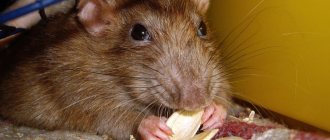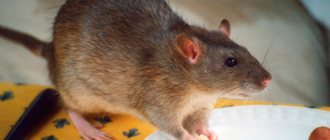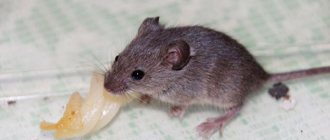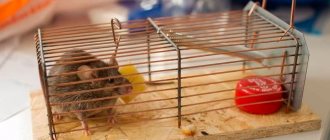Which cats catch mice and rats, heredity and upbringing
Let's look at which cats are better at catching mice. First of all, the success of the hunt depends on the color of the pet. If the color of the animal is black, gray, red, there are dim spots or stripes, then it will be much more convenient for him to hunt, it will be easier for him to merge with nature.
Domestic rat-catching cats catch mice because of the hunter's instinct, developed in them since childhood. All harmless games with a pet using “teasing” are actually preparing the pet to pursue and prey on its prey.
Homeless yard animals, just like domestic animals, follow their instincts. For them, hunting serves as a direct source of food and a way to survive.
There is an opinion that castrated cats are worse at catching mice and rats. Your pet's behavior can change greatly after sterilization. Because of this, many rural residents wonder whether a neutered cat will also deftly exterminate rodents or will it lazily sleep all day long.
Hypothetically, the hunting instinct should not be lost in the pets of rat catchers. However, in reality everything happens differently. If the rat catcher cat does not eat properly, it quickly gains weight, which causes laziness, apathy and leads to a slowdown in metabolism. It will be very difficult for the pet to hunt, so it may stop exterminating rodents. The rat catcher needs to be fed correctly after sterilization.
It is believed that the difference between outbred and purebred animals lies not only in appearance, but also in the complete absence of hunting instincts in the latter.
Owners of domestic cats believe that only domestic animals, which have been trained from childhood by their mother mousetrap to obtain food, can be rat catchers. However, this is not quite true. There are many purebred pet rat catchers who catch mice no worse than domestic ones.
Why do cats bring caught mice to their owners?
There are several reasons why pets catch mice: entertainment, food, defense of territory, caring for their offspring or owners.
The cat catches a rat, plays with it and releases it, or eats it. There are different scenarios for the development of events after a cat passes by its owners with a mouse in its teeth. No one could fully understand why the cat plays with the mouse.
Mice and rats can serve as food for both indoor and outdoor cats. With only one difference - pet rat catchers do not eat mice so much and not so often, since they have enough food given by their owners.
Ratcatcher cats value their possessions very much, mark their territory and even protect it from uninvited guests. You can often hear the guttural sounds of cats preparing to attack an enemy who has entered their territory. Ratcatcher cats also protect the house from mice. Cats don’t need extra “guests”.
Many people do not understand why cats bring mice to kittens - they teach them to hunt and help them get additional food until they become independent hunters.
Some pets become very attached to the owner and therefore, if the pet brought its prey to him, then there may be several reasons for this - perhaps they want to feed their inept packmate, boast about their hunting skills, or thank the owner for his care.
Cats also bring their prey to the doorstep because they want to save their prey for later so that there is a supply of food in case the animal gets hungry. In any case, pets should not be punished. Praise the rat catcher, pet him, accept the gift and carefully throw it away.
Who is better at catching mice, a cat or a cat?
When purchasing a pet or taking an animal from the street, people often wonder who would be better at catching mice: an affectionate female or a willful male.
It is believed that female ratcatchers are better at hunting rodents. Maternal instinct by its nature pushes her to hunt. A cat with a rat in its teeth runs to feed its fragile cubs.
Cats also catch rodents, but their main activity is searching, capturing and fertilizing a suitable female for procreation. Therefore, cats hunt less than females. They are able to hunt not only rodents, but can also cope with other pests (moles, snakes, birds). It follows from this that it is best for owners of private houses to have female rat catchers.
Source
What breed of cat is best at catching mice?
When it comes to catching mice, no innovative device can compare with a smart house cat. Fluffy pets have won the love of humans thanks to their ability to destroy rodents. Today, breeders keep cats for the hobby, so pets usually lead a passive lifestyle. For people living in rural areas and having a subsidiary farm, it is important that the cat knows how to catch mice and rats. Rodents periodically appear in every country house and are capable of destroying food and causing diseases. Which cats are better at catching mice, and which breeds are not suitable for hunting?
How to care for a cat?
We've talked a lot about how to choose the perfect cat for hunting mice and rats. We have one more question left to answer. How to properly care for your four-legged friend? There's really nothing complicated about it. Make sure you keep them up to date on their vaccinations, especially if they spend a lot of time outside. Rodents such as mice, rats and voles can carry diseases and parasites. This means that you need to give your cats anthelmintic drugs and show them to the veterinarian once every six months. Also, make sure that you do not use pesticides or chemical products to control rodents around your property. Your cat may come into contact with these chemicals and become sick. Feed your animals natural products. Your cat also needs freedom and space where he can rest, play and walk.
If you're thinking about getting a cat for pest control, these are the best breeds to consider. Remember, if your pet is not up to the task, you can always trust our company to provide humane traps and repellents.
The role of living conditions
The hunting instinct is present in cats, regardless of variety and gender. To test your skill, you need to scratch your finger across the floor and observe the pet’s behavior. The faster the animal reacts to the sound, the stronger the hunting instinct is. If the cat immediately rushes to the hand, it will be good at catching mice.
Pets living in an apartment and not walking in the yard can catch a mouse, but they will not kill or eat the pest. Animals with the appropriate instinct feed on mice, which can only be taught to a kitten by a mother mousetrap. Animals that grew up in villages or on the street are better at catching rodents, because from childhood they know what a mouse is and how to behave with it. For outdoor cats, hunting is the main way of obtaining food.
Questions about breeds and external characteristics.
As has already been noted, the best mousecatchers are cats raised in appropriate conditions.
Although some experts insist that there are still breeds of mousecatchers. These are all European cats with short hair. In this category, the following are distinguished by color :
- European tabby. Outwardly, it resembles a small tiger. Cats of this breed are very strong and stocky. They don't just catch mice, they ruthlessly destroy them.
- European speckled. These are good mouse hunters of various parameters. They also catch lizards, snakes, small birds and fish.
The class of long-haired cats includes:
- Turkish Angora. This is a gorgeous cat. Her fur and tail are white. They are fluffy and adorable creatures, most often with blue eyes. However, she also catches mice skillfully and gracefully kills them.
- Norwegian forest species. Its representatives have thick clothing. They are excellent at catching both mice and large rats.
The importance of a pet's appearance
Success in catching rodents depends on the conditions in which the kitten grew up and the appearance of the animal. Color plays a significant role, serving as natural camouflage. The most preferred are discreet fur coat colors: gray, black, brown. A cat with a motley or tortoiseshell color will blend into the surrounding landscape. The second significant point is the length of the coat. When wet, the long fur acquires a specific odor, which serves as a signal for rodents that a predator is approaching. Therefore, short-haired cats find it easier to hunt in the rain.
IT IS IMPORTANT TO KNOW! When choosing a ratcatcher kitten, you need to pay attention to the whiskers . Thanks to the vibrissae, the pet navigates in the dark, picks up air vibrations, and estimates the distance to the mouse.
By what signs can you recognize a rat catcher?
A mousetrap cat is not a breed, but a rare skill that a pet develops due to the conditions of its keeping and upbringing. The best hunters are considered to be mongrel cats, who have had to hunt mice for food since childhood. Street animals are not spoiled by the attention and care of the owner, so the hunting instinct develops and is preserved for a maximum period.
The following signs will help you recognize a future rat catcher in a kitten:
The listed signs increase the likelihood of a successful hunt. But the development of the skill depends on the conditions of detention and upbringing. If you keep your pet in an apartment and give it food when called, the hunting instinct will “die out.”
Who is better to have
It is impossible to clearly say who is better, a cat or a female cat.
It is impossible to give a clear answer about the gender of a future pet in an apartment or in your home. Cats and cats have positive and negative characteristics inherent to their gender. Therefore, each owner has the right to decide who to choose and adopt independently, taking into account the distinctive features of both sexes.
| Behavior criterion | Cat | Cat |
| Cleanliness | Less clean, more pronounced odor when kept | Clean, minimal odor when kept |
| Character | More dominant, marks territory, moody | More affectionate, gets her way with cunning, does not mark territory |
| Reproduction | Aggression when attracted, will not bring kittens home | Demanding during heat, can get pregnant. |
In terms of reproduction and its prevention, cats are much simpler.
Males cannot become pregnant, and aggression can be reduced by castration. With a cat the situation is complicated. Sterilizing a cat is more difficult, dangerous and expensive.
Taking into account the pros and cons of the main criteria for the behavior of pets regarding gender, we can conclude that a cat will be less of a hassle to keep in an apartment.
Can neutered cats catch mice?
It is believed that spaying and castration does not affect the hunting skill of a pet. In practice, things are different. Such operations often have a negative impact on the animal’s behavior and physiological state. If you castrate a cat, the animal becomes lazy and passive, sleeps for a long time, not interested in what is happening around. Also, after castration, cats gain excess weight, which interferes with successful hunting. To ensure that the rat catcher does not lose his skills, after the operation the animal must be fed with suitable dietary food and stimulated to be active.
Nutrition question
An animal that regularly hunts mice needs to be properly fed. The physical condition, strength, and endurance of the pet depend on the nutritional characteristics. Domestic cats rarely eat prey; more often they simply strangle the mouse. Only a street or hungry cat can eat a rodent.
The animal can be fed natural food or industrial feed. The main thing is that the pet eats suitable and healthy food that suppresses hunger, saturates the body with vitamins and minerals, and strengthens the animal’s immune system.
ON A NOTE! Most domestic cats catch mice for fun, but do not eat rodents.
Suitable breeds
The best mousecatchers are native cat breeds that appeared naturally and have not undergone significant transformation. Compared to artificially bred ones, hunting skills in such breeds have been developed over centuries, which has given the corresponding result.
Maine Coon
Maine Coon cats are the best hunters of mice and rats. Maine Coons are distinguished by their large size and strength, which does not prevent them from gracefully jumping and chasing prey in hard-to-reach places. Maine Coons are gambling animals. A cat can chase a rat for hours, ignoring heat, cold, and rain. Thanks to its thick coat, the animal feels comfortable in the cold and can spend a long time outdoors. Large body sizes make it possible to destroy large rodents, which repel smaller rat catchers. Maine Coons prefer to spend time in the yard; country life is an ideal option for them.
Russian blue
Due to its compact size and aristocratic appearance, village house owners doubt the hunting skills of the Russian Blue cat. The lack of heavy weight is compensated by a quick reaction and the ability to move quietly around the yard. The Russian Blue cat tracks rodents of any size, which serves as the main entertainment for the pet. The cat's movements are graceful and precise, the speed of movement is amazing. The owners of Russian blue cats confirm that they hear any rustle and leave no chance for the mice to survive.
Siberian
The skill of catching mice among Siberians has been confirmed by more than one generation. The pet is large in size and has thick fur, which allows it to pursue prey in any weather conditions, moving silently. The role of sound insulation is performed by fluffy pads on the paws. Siberian cats move in jerks and make long jumps, which allows them to cope with the prey. Since Siberians are not attached to their owner and home, pets spend most of their time outside, ambushing rodents. When the Siberian cat is busy tracking down prey, it ignores the call of a person and the feeling of hunger, plunging into the hunt. It is recommended to get a breed for people living in the northern regions.
Kurilian Bobtail
They are distinguished by their attachment to the owner. Kurilian bobtails have a canine disposition and are ready to protect their owner from all threats and misfortunes. According to the cat, the main danger to humans is the mouse, so the pet devotes all its energy to tracking down and eliminating the rodent. Kurilian bobtails have powerful hind legs, allowing them to develop great speed and make long jumps. The animal moves from place to place with ease and is capable of destroying broods of mice. Thanks to its determination and courage, the Kurilian Bobtail is not afraid to get into a fight even with a medium-sized dog, so the owner does not have to worry about the safety of the yard. The cat will guard and defend the territory of the house until the end.
Nibelung
A rare breed of domestic cats with a difficult character. Nibulungs are proud and freedom-loving. The animal will not let a person near until it is convinced of his kindness and reliability. English origin and royal appearance do not prevent the Nibelungs from destroying the mice that have settled in the house. Due to their thick, long fur, Nibelungs require grooming, otherwise the pet will develop voluminous mats.
Cymric
In appearance they resemble yard cats and have a short tail like a bobtail. It is believed that an elongated tail makes hunting easier, but practice shows the opposite. Thanks to the original structure of the body, the Cymrik is perfectly oriented in space and moves gracefully. Strong paws and sharp claws make the animal a successful rat catcher. Cats have a playful disposition and are active; they love to spend time outside, hunting for rodents. To stay fit and healthy, the animal needs long walks and fresh air. It is recommended to keep them in a private house in an open area.
British Shorthair
Because of their cute faces and plush fur, Britons are considered sissies and couch potatoes, but these purebred animals make the list of the best rat catchers. The British have a well-developed hunting instinct and have the necessary inclinations. To please the owner, to receive rewards and praise, the animal is able to catch and bring prey in its teeth. Since British Shorthairs are compact in size (weighing rarely more than 5 kg), they often hunt mice and young rats. They rarely enter into battle with large individuals.
The best mouse breeds
Theoretically, we can say that all cats, without exception, can fight mice and rats. There is an explanation for this - the animals come from wild cats, which were predators, and the basis of their diet were mice and rats. That is, purrs have hunting instincts inherent in nature itself, but not every predator is a mouser in practice.
As for the servants, they catch mice and rats not only out of natural instinct, but driven by hunger. When purchasing a mousetrap animal, you should pay attention to its external features. It is best to buy a cat, not a male cat. Her brain is tuned to protect her offspring, which may be why she is better at catching mice and rats.
The head of rat-catching cats must have a somewhat triangular shape. This is easy to check - if, when choosing an animal, you press the fur and ears to the base of the skull, a triangle should form in appearance.
Cats with true hunting instincts should have large ears. But such representatives of the breed will require large financial expenses. This includes the Abyssinian cat. It is desirable that there are tassels at the tips of the ears - like a Maine Coon.
The tricolor cat is excellent at catching mice. There is simply no such color in a cat. It is best to choose an animal that is black, gray and white in color, which will allow it to camouflage itself in the wild and at home.
Experts advise purchasing a specific breed of cat that is most suitable for catching rodents. Among them, the European Shorthair is distinguished. She is an active, intelligent, insightful, inquisitive and brave animal. Short-haired cats react normally to low temperatures, have a gentle, pleasant timbre of their voices and live quite a long time.
The term "European Shorthair" refers to all domestic cats that have short hair and are found in a number of European countries. Individual breeds are classified according to color.
Among them, excellent hunters are cats such as European tabbies. Externally, representatives of this species resemble a miniature tiger. They have a massive muscular body, a strong head, pronounced cheeks, broad shoulders, with characteristic stripes on the surface of the coat. This pattern consists of lines that are not interrupted or are interspersed with brown and tan colors.
The European tabby is an excellent rodent catcher. He is delightfully brave and merciless to pests. Animals of this variety are highly valued - financially and functionally.
European speckled cats are also worthy of attention. They happily catch not only mice of all sizes, but also snakes, small mammals, green lizards, fish, and birds. They are distinguished from the European tabby by a more elongated body and less pronounced cheeks.
A characteristic difference of the species is the presence of three black stripes on the back, which form a belt in the area from the back of the neck to the tail itself. On the cat's shoulders there are black spots that form a butterfly, and on the sides there are curls that look like a fan. As for color, the European speckled cat can come in a variety of shades.
It is worth paying attention to the Turkish Angora. Externally, this is an animal with white fluffy fur and a tail, blue or multi-colored eyes. These species are better than many at hunting mice and rats. At the same time, cats prefer to live in comfortable home conditions, do not suffer without walks on the street, and can always boast of beautiful fur and a presentable appearance.
The Turkish Angora was once brought from its ethnic country to others as a valuable gift. The cubs of this cat were considered a special luxury. In European countries, the Turkish Angora appeared only at the end of the 16th century. And by the beginning of the 19th century it became the most common, since at that time there were almost no other long-haired species.
How to teach a cat to catch mice?
Mousecatchers are found among purebred and outbred cats. In order not to make a mistake, it is recommended to figure out in advance what criteria to choose a kitten by. Attention is paid not to the physical structure, color or breed, but to the parents. If the father or mother is good at catching mice, they will teach the kitten the skill. Therefore, you should first ask the owners how good hunters the parents were. A reasonable option is to go to the nearest village to pick up the kitten. Animals growing outside chase flies, butterflies and other insects, which develops the hunting instinct.
It is difficult to teach a domestic cat to hunt; the instinct must be developed from childhood. The owner needs to purchase appropriate toys, lined with fur, and constantly tease the kitten so that he runs after them. You should develop your pet's agility, reaction speed, coordination and endurance. To attract your pet's attention, the toy can be soaked in a decoction of catnip. As an alternative, you can catch the mouse and show the rodent to your pet. The kitten will interest her. You can only remove a mouse when the animal has had enough of playing with the pest and strangled it.
FACT! To teach a domestic cat to hunt, many owners limit their diet, which serves as an incentive to catch mice.
What cats catch mice and rats
Many owners living in the private sector are specifically looking for mousecatchers. However, identifying them is not always easy. Some rely on genetics. In other words, if the mother was a mousetrap cat, then the kitten will inherit her gift. Another option is breed.
Mousecats are especially needed in private homes
There is no doubt that certain members of the cat family have a greater propensity for catching rats or mice. However, there are other ways to determine which cats are better at catching rats and mice.
How to identify a rat-catcher cat
The first thing you should pay attention to is the color of the animal. Representatives with gray, black, brown, or red skin blend better with nature and, as a result, are more successful hunters. White, unfortunately, in this case, is the most losing.
The second point is education. It is very important how the kitten behaved in childhood. Outdoor games with a bow, a ball, chasing the light of a laser pointer - all this is the preparation and development of hunting instincts.
For your information! Yard cats and female cats are excellent mousecatchers. The point is also that they develop their instincts from childhood. Hunting for them is a way to survive.
An equally interesting question is whether the rat-catcher cat will continue to hunt after castration. The animal's behavior changes after this operation, but this does not mean that it will lose its innate and developed instincts. The only thing you should be careful of in this situation is overfeeding your pet. Such measures often lead to obesity, and, as a result, hunting skills decrease. Therefore, a neutered cat should be given a special diet, so that he will continue to perform the task assigned to him.
Hedgehogs for catching mice
Even hedgehogs - especially long-eared ones, which are predators, are quite capable of dispersing swarms of mice from their habitat. Owls, which have recently become fashionable to keep as pets, are truly “professionals” of mouse hunting. Well, who, who, but an owl (and almost any one) catches mice not out of fear, but out of conscience - after all, its life and the life of its chicks depend on it.
In conclusion, I would like to note that it is not for nothing that cats are famous as mousecatchers, but recently many of them have had little opportunity to demonstrate their hunting qualities. After all, it is well known that the cat that catches mice best is a cat... which feeds on them, and does not just want to have fun out of boredom. As for the opinion that a cat catches mice better than a cat because she has to feed kittens, this is nothing more than another myth. Cats catch mice no worse than their friends, and sometimes they can even give them a head start.
BEST RAT AND MICE HUNTER
Themes mouse cats pets
Who is better at catching: a cat or a cat?
The question of who is better at catching mice and rats, a cat or a cat, also often worries owners who are planning to take an animal into the house. You might think that females are better hunters due to their developed maternal instinct. Indeed, a girl must provide food not only for herself, but also for her kittens. In addition, the cat’s genetics is less about hunting and more about procreation. The male must find and fertilize the female, so the hunter's instinct is slightly less developed in him.
Important! If a rat-catcher cat appears in the house, owners should take one point into account. Felines can deal not only with pests (moles, mice, rats, snakes), but also with some poultry, such as ducklings and chickens. In this case, the animal should be raised correctly.
Cats squabble, mice are welcome (proverb)
If there is already a cat living in the house, but it has not succeeded in catching rodents, the second pet should be of the opposite sex. One of the pets will have to be castrated, otherwise constant “weddings” are inevitable, knocking the hunter out of her “schedule”. There has been a lot of research into whether neutered cats catch mice.
It has been proven that sexual desire only hinders a cat, and does not spur it on. A sterile cat, having forgotten about “partying”, devotes more time to games and hunting, and therefore is more successful. A castrated cat will not hunt less if he enjoyed this activity before the procedure. But if all his thoughts were occupied only with the search for partners, castration is unlikely to awaken in him a passion for hunting, although this also happens.
Two cats are the worst option: they will sort things out, forgetting about the mice that are getting bolder every day. Two cats can coexist peacefully if there is enough space and love in the house for both. Perhaps a more successful hunter will even become an example and be able to interest a lazier cat.
We invite you to read: Roundworms in cats and kittens: symptoms and treatment
The main signs of a rat catcher and a mouse catcher
Should you pay attention to the appearance of the animal? Many people believe that rat-catching cats stand out among their relatives. This is both a true and a false opinion.
Almost every member of the cat family can be made an excellent hunter if its external characteristics meet the requirements. First of all, you should pay attention to the color of the animal. It shouldn't be too bright. The most suitable colors are black, gray, striped.
It is believed that the most suitable huntresses are females with three colors (black, red and gray). There is also an opinion that a good hunter must have large ears and short hair. The latter is a really well-known fact. Among the long-haired rat-catching cats, the following breeds stand out: Turkish Angora, Norwegian Forest, Siberian, Maine Coon. As a rule, a fluffy coat is more of a hindrance to the hunter.
The shape of the head is another thing to pay attention to. Mousecatchers have a triangular head. It is also believed that large ears, especially with tufts, are another striking sign of a good hunter.
A few tips regarding selection, what you should pay attention to when choosing a kitten for hunting rats and mice:
Important! You should remember to take care of your pet hunter. If an animal has been bitten by a rat, it must be taken to a veterinarian to be tested and given injections in case of rabies infection.
What does a triangular muzzle mean?
By what external signs can one identify a future mousetrap?
It is believed that a cat that can successfully catch mice must look the part. What signs can be used to determine which kitten will be an excellent rodent exterminator?
Signs of a mousecatcher:
- long mustache;
- wild color - black, red or gray, two or three colors, with faint stripes and spots to blend with nature and remain invisible to its prey;
- short hair – long and thick guard hair when wet acquires an unpleasant odor, which can scare away the rodent;
- large ears and triangular head;
- large paws.
They tried to choose the best rat catcher using these signs several decades ago. In reality, there are no perfect rat hunters. Every cat has a hunting instinct from birth, but not all representatives of the feline family realize it with equal success.
Before you take a kitten into your home to catch mice, you should ask whether its mother was a good hunter. When raising their cubs, cats pass on their skills to them, including in catching rodents.
If the pet was taken from the street, it is highly likely that its hunting skills will be well developed. In purebred pets, the instinct is dulled, especially if several generations of animals have lived in apartments and do not even know what a mouse or rat looks like.
Is it possible to teach a cat to hunt if she doesn't show much desire to catch mice? In order for the animal’s natural instincts to awaken, it is necessary to let the pet feel a slight feeling of hunger. A cat should not be completely deprived of food - this is cruel and fraught with health problems. You just need to reduce the portion size: malnutrition will awaken the instinct in your pet. After the first successful hunt, it is advisable to reward the animal.
You need to teach your pet to hunt from childhood. There is no point in training an adult castrated cat. The purpose of its existence is food and sleep, such animals become lazy and quickly gain excess weight, and it becomes more and more difficult for them to run every year. But you can and should awaken a kitten’s interest in hunting. To do this, catch the mouse using a mousetrap and let your child play with it while it is still alive.
To activate the kitten's hunting instinct, you should play with it more often using a laser pointer or special toys. If your pet tirelessly chases them, he will become a professional in catching mice.
The main signs of a rat catcher and a mouse catcher
Should you pay attention to the appearance of the animal? Many people believe that rat-catching cats stand out among their relatives. This is both a true and a false opinion.
Metis cat: main options for variety of crossbreeds
Almost every member of the cat family can be made an excellent hunter if its external characteristics meet the requirements. First of all, you should pay attention to the color of the animal. It shouldn't be too bright. The most suitable colors are black, gray, striped.
It is believed that the most suitable huntresses are females with three colors (black, red and gray). There is also an opinion that a good hunter must have large ears and short hair. The latter is a really well-known fact. Among the long-haired rat-catching cats, the following breeds stand out: Turkish Angora, Norwegian Forest, Siberian, Maine Coon. As a rule, a fluffy coat is more of a hindrance to the hunter.
The shape of the head is another thing to pay attention to. Mousecatchers have a triangular head. It is also believed that large ears, especially with tufts, are another striking sign of a good hunter.
A few tips regarding selection, what you should pay attention to when choosing a kitten for hunting rats and mice:
- First of all, it should be remembered that the rat is a very large animal, therefore the hunter himself must be of rather large size. He must have well-developed muscles and skeleton. Powerful jaws are also very important. It should also be remembered that a lazy, immobile cat cannot perform the function of a hunter;
- The breed of rat-catcher cats is of great importance. In this matter, you cannot choose artificially bred representatives. Such selection negatively affects skills and dulls natural instincts;
- picking up an animal from the street does not mean you are guaranteed to get a rat catcher. Most street purrs are abandoned pets. Therefore, no one will give any guarantees;
- The best chance of getting a good hunter is to take a grown baby (3-4 months) from a rat-catcher mother. It's not just a matter of genetic predisposition. In the first months of life, the mother teaches her babies all the necessary skills, coupled with natural instincts. This is why you should give preference to already grown kittens;
- The cat's head should be a triangle. To accurately check, you need to press the animal's ears. Why is this worth paying attention to? This is how the hunter gene manifests itself in nature.
Important! You should remember to take care of your pet hunter. If an animal has been bitten by a rat, it must be taken to a veterinarian to be tested and given injections in case of rabies infection.
Popular rat catcher breeds
As already mentioned, in the matter of choosing an animal for catching rodents, the breed is not the least important. There are a number of felines that are endowed with a strong hunter gene. If we consider purely physical data, they will differ in the above characteristics.
Russian blue
One of the most prominent representatives. The Russian Blue is not one of those who will sit in ambush for hours and watch its prey. She attacks quickly and swiftly, almost always overtaking her target.











